One of the most rewarding experiences of riding a bicycle in Thailand is the cornucopia of food that greets you at every bend in the road. From seaside restaurants and mountain village fresh markets to the curbside food stands that fill the walkways of every small town, Thailand has a love affair with food. Amongst the most popular lunch and quick meal options is the ubiquitous Raan Guay Dtiaao (rice noodle shop).
Sidling up to a noodle stand and enjoying a delicious bowl of Guay Dtiaao is a wonderful way that cyclists can quickly, and inexpensively, refuel their cycling muscles. Everyday cyclists and those who plan to do a bit of touring in the land of smiles will benefit greatly by acquainting themselves with the unique signage that adorns Thailand’s most prominent and well-known chains of noodle stands. These noodle stands are sold to individual operators in a sort of franchise method, ensuring good location placement and familiar products throughout Thailand. This is great news for touring cyclists who are concerned with finding a good, quick meal at an affordable price that they can repeatedly find along the entire route of their journey.
The first of these chain noodle stands is called Old Daeng. Arguably the chain of noodle stand with the most locations Old Daeng can be found in front of schools and office buildings, along busy roadsides, and even literally, in the middle of nowhere. This author has come across Old Daeng noodle stands in every province of Thailand.
The second of these chain noodle stands is called Champ. This chain of noodle stand is to be found along roadsides and in market areas. Popular with late night revelers and road tripping caravan drivers, the taste of the noodles at these stands has little to no deviation from location to location.
The third of these chain noodle stands is called Gai Haa Daow (5-Star Chicken). This particular chain of noodle stands began by selling only rotisserie style chicken and sticky rice, but the brand has expanded its food stand offerings to include several different noodle dishes. Bowls of savory Guay Dtiaao (rice noodles) and Ba Mee (Chinese egg noodles) can be had at Gai Haa Daow stands. This author is also not entirely above the idea of gobbling up an entire rotisserie chicken after a 120km riding day.
Now that you know what you are looking out for let’s discuss the ordering process and approximate costs that you should expect at these noodle stands.
First off, learn and remember the word Guay Dtiaao. This is the word for rice noodles. Sometimes just saying this much with a hungry look on your face will get you a steaming bowl of deliciousness, but it is best to learn a few additional words to make the entire noodle buying/eating experience that much more enjoyable.
Second, learn a few words that will help you tell the stand operator what type of meat you would like to have added to your noodle soup. Some noodle stands will only have one option of meat while others may have all three to choose from. The most famous thing to add to the noodle soup is a ball of meat made from pork or fish. These balls of meat are known as Luk Chin. If you’d rather not have meat in your noodle soup simply say Mai Sai ______ (Muu, Plaa, Neuua).
The word for fish is: Plaa
The word for pork is: Muu
The word for beef is: Neuua
Third, learn Sen Lek (thin noodle) and Sen Yai (fat noodle). These words uttered after Guay Dtiaao will tell the noodle stand operator what size noodles you’d prefer to have in your noodle soup.
Lastly, learn Sai Naam and Mai Sai Naam. Saying one of these options will get you your noodles swimming in hot broth or sitting in a dry bowl. Most often Guay Dtiaao is served in a hot broth of water and flavoring, but on occasion some noodle stand patrons like to have their noodles without the hot broth and so order their style as Mai Sai Naam (without water/hot broth).
So let’s do a recap of the ordering process, shall we. You’re a hungry cyclist with countless kilometers in your legs and 100 Baht in your pocket. You’re riding through the small town/village of ________ and you spot a sign that you now know is a Champ noodle stand. You park your bicycle nearby and approach the proprietor with confidence (and a very hungry look on your face) and say;
Guay Dtiaao Muu, Sen Lek, Sai Naam, Khap
Translation: Rice noodles with pork, thin noodles, with water/hot broth, please.
Khap is the politeness article spoken by men in the Thai language.
OR
Guay Dtiaao Plaa, Sen Yai, Mai Sai Naam, Khaa
Translation: Rice noodles with fish, large noodles, without water /hot broth, please.
Khaa is the politeness article spoken by women in the Thai language.
OR
Guay Dtiaao Mai Sai Luk Chin, Sen Yai, Sai Naam, Khap
Translation: Rice noodles without balls of meat, large noodles, with water/hot broth, please.
When you’ve finished up your bowl of noodles it is time to settle up the bill. A bowl of Guay Dtiaao will cost approximately 25-35 Baht, across the entire country, regardless of how you have ordered it (i.e. ordering it without meat or without hot broth does not reduce the price). Now it’s time to go and find an ice coffee cart and add some sugar and caffeine to your muscles.
Read How to Order Thailand’s 7 Most Common Foods here – http://bicyclethailand.com/touring-cyclist-menu-how-to-order-the-7-most-common-dishes-in-thailand/
Planning a cycling trip in Thailand? Want to remove some of the guesswork when it comes to routes and information? BicycleThailand.com offers GPS route data for touring cyclists that can be used on a GPS device, smartphone, or tablet. These routes can be viewed on your device regardless of internet access during your Thailand cycling adventure. Learn more about our Thailand GPS cycle touring routes.
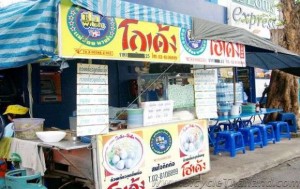
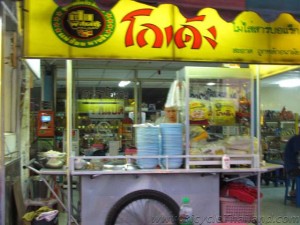
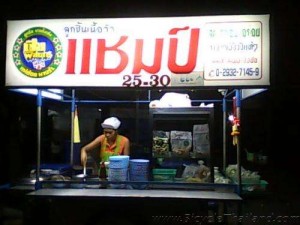
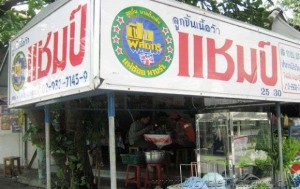

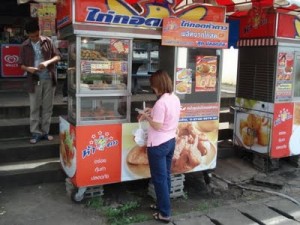
Thanks for the article. Cycling in Thailand is only slightly more dangerous than eating the food, especially the street food. – Bangkok Urban Obstacle Cyclist
An adventurous lifestyle requires an adventurous and robust gut. If you can’t stand the heat, stay out of the kitchen ;-)